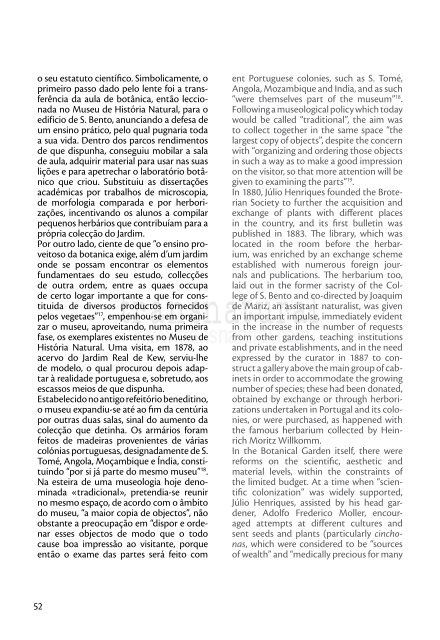Jardim Botânico de Coimbra: contraponto entre a Arte e a ... - artez
Jardim Botânico de Coimbra: contraponto entre a Arte e a ... - artez
Jardim Botânico de Coimbra: contraponto entre a Arte e a ... - artez
Create successful ePaper yourself
Turn your PDF publications into a flip-book with our unique Google optimized e-Paper software.
o seu estatuto científico. Simbolicamente, o<br />
primeiro passo dado pelo lente foi a transferência<br />
da aula <strong>de</strong> botânica, então leccionada<br />
no Museu <strong>de</strong> História Natural, para o<br />
edifício <strong>de</strong> S. Bento, anunciando a <strong>de</strong>fesa <strong>de</strong><br />
um ensino prático, pelo qual pugnaria toda<br />
a sua vida. Dentro dos parcos rendimentos<br />
<strong>de</strong> que dispunha, conseguiu mobilar a sala<br />
<strong>de</strong> aula, adquirir material para usar nas suas<br />
lições e para apetrechar o laboratório botânico<br />
que criou. Substituiu as dissertações<br />
académicas por trabalhos <strong>de</strong> microscopia,<br />
<strong>de</strong> morfologia comparada e por herborizações,<br />
incentivando os alunos a compilar<br />
pequenos herbários que contribuíam para a<br />
própria colecção do <strong>Jardim</strong>.<br />
Por outro lado, ciente <strong>de</strong> que “o ensino proveitoso<br />
da botanica exige, além d’um jardim<br />
on<strong>de</strong> se possam encontrar os elementos<br />
fundamentaes do seu estudo, collecções<br />
<strong>de</strong> outra or<strong>de</strong>m, <strong>entre</strong> as quaes occupa<br />
<strong>de</strong> certo logar importante a que for constituida<br />
<strong>de</strong> diversos productos fornecidos<br />
pelos vegetaes” 17 , empenhou-se em organizar<br />
o museu, aproveitando, numa primeira<br />
fase, os exemplares existentes no Museu <strong>de</strong><br />
História Natural. Uma visita, em 1878, ao<br />
acervo do <strong>Jardim</strong> Real <strong>de</strong> Kew, serviu-lhe<br />
<strong>de</strong> mo<strong>de</strong>lo, o qual procurou <strong>de</strong>pois adaptar<br />
à realida<strong>de</strong> portuguesa e, sobretudo, aos<br />
escassos meios <strong>de</strong> que dispunha.<br />
Estabelecido no antigo refeitório beneditino,<br />
o museu expandiu-se até ao fim da centúria<br />
por outras duas salas, sinal do aumento da<br />
colecção que <strong>de</strong>tinha. Os armários foram<br />
feitos <strong>de</strong> ma<strong>de</strong>iras provenientes <strong>de</strong> várias<br />
colónias portuguesas, <strong>de</strong>signadamente <strong>de</strong> S.<br />
Tomé, Angola, Moçambique e Índia, constituindo<br />
“por si já parte do mesmo museu” 18 .<br />
Na esteira <strong>de</strong> uma museologia hoje <strong>de</strong>nominada<br />
«tradicional», pretendia-se reunir<br />
no mesmo espaço, <strong>de</strong> acordo com o âmbito<br />
do museu, “a maior copia <strong>de</strong> objectos”, não<br />
obstante a preocupação em “dispor e or<strong>de</strong>nar<br />
esses objectos <strong>de</strong> modo que o todo<br />
cause boa impressão ao visitante, porque<br />
então o exame das partes será feito com<br />
52<br />
ent Portuguese colonies, such as S. Tomé,<br />
Angola, Mozambique and India, and as such<br />
“were themselves part of the museum” 18 .<br />
Following a museological policy which today<br />
would be called “traditional”, the aim was<br />
to collect together in the same space “the<br />
largest copy of objects”, <strong>de</strong>spite the concern<br />
with “organizing and or<strong>de</strong>ring those objects<br />
in such a way as to make a good impression<br />
on the visitor, so that more attention will be<br />
given to examining the parts” 19 .<br />
In 1880, Júlio Henriques foun<strong>de</strong>d the Broterian<br />
Society to further the acquisition and<br />
exchange of plants with different places<br />
in the country, and its first bulletin was<br />
published in 1883. The library, which was<br />
located in the room before the herbarium,<br />
was enriched by an exchange scheme<br />
established with numerous foreign journals<br />
and publications. The herbarium too,<br />
laid out in the former sacristy of the College<br />
of S. Bento and co-directed by Joaquim<br />
<strong>de</strong> Mariz, an assistant naturalist, was given<br />
an important impulse, immediately evi<strong>de</strong>nt<br />
in the increase in the number of requests<br />
from other gar<strong>de</strong>ns, teaching institutions<br />
and private establishments, and in the need<br />
expressed by the curator in 1887 to construct<br />
a gallery above the main group of cabinets<br />
in or<strong>de</strong>r to accommodate the growing<br />
number of species; these had been donated,<br />
obtained by exchange or through herborizations<br />
un<strong>de</strong>rtaken in Portugal and its colonies,<br />
or were purchased, as happened with<br />
the famous herbarium collected by Heinrich<br />
Moritz Willkomm.<br />
In the Botanical Gar<strong>de</strong>n itself, there were<br />
reforms on the scientific, aesthetic and<br />
material levels, within the constraints of<br />
the limited budget. At a time when “scientific<br />
colonization” was wi<strong>de</strong>ly supported,<br />
Júlio Henriques, assisted by his head gar<strong>de</strong>ner,<br />
Adolfo Fre<strong>de</strong>rico Moller, encouraged<br />
attempts at different cultures and<br />
sent seeds and plants (particularly cinchonas,<br />
which were consi<strong>de</strong>red to be “sources<br />
of wealth” and “medically precious for many


